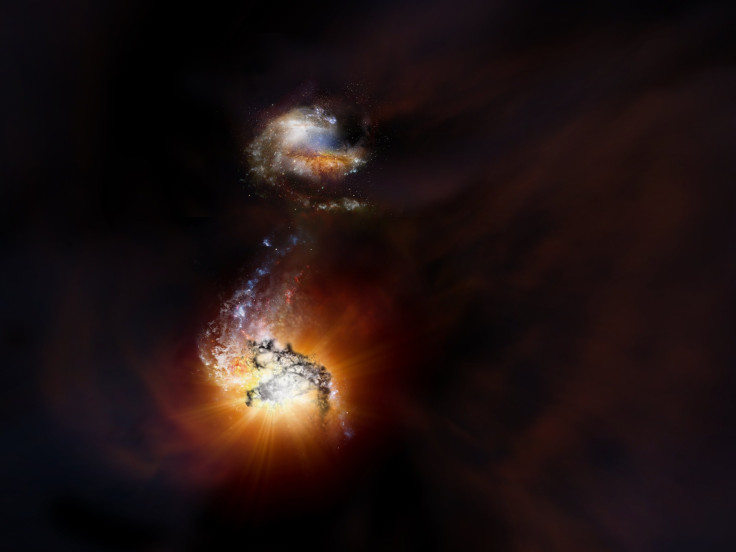Massive, Bright Galaxies From Early Universe Found Merging, Causing 'Violent Star Formation'

About 12.7 billion light-years away from Earth, in the general direction of the Dorado constellation, something very unusual is going on. "Two astoundingly bright and spectacularly massive galaxies" in the region are in the process of merging with each other, a process which once complete, will form a single humongous elliptical galaxy that may become the core of a galaxy cluster.
Given the distance of ADFS-27, as the galaxy pair is called, it is seen from Earth as it existed barely one billion years after the Big Bang and the birth of the universe. That was a time when "hyper-luminous starburst galaxies" — the kind that both the ADFS-27 galaxies are — were extremely rare, since the earliest galaxies were just forming around then.
"Discovering a hyper-luminous starburst galaxy is an extraordinary feat, but discovering two — this close to each other — is amazing. It’s nearly 13 billion light-years away and in its frenzied star-forming action, we may be seeing the most extreme galaxy merger known," Dominik Riechers from Cornell University in Ithaca, New York, and lead author of a paper published Monday in the Astrophysical Journal, said in a statement.
ADFS-27 was first spotted as a faint red dot (the color was a clue to its distance) by the European Space Agency’s Herschel Space Observatory, and then observed by the Atacama Pathfinder Experiment to confirm the object was actually very bright and very far. The Atacama Large Millimeter/submillimeter Array (ALMA) of radio telescopes, with its higher resolution and sensitivity, calculated the precise distance of the object and found it to be two separate galaxies.
ALMA observations also suggest the amount of star-forming gas in the ADFS-27 system is about 50 times that in the Milky Way, which causes it to produce stars very rapidly.
"Much of this gas will be converted into new stars very quickly. Our current observations indicate that these two galaxies are indeed producing stars at a breakneck pace, about one thousand times faster than our home galaxy," Riechers said in another statement.
Merging galaxies in the early universe captured with ALMA. from NRAO Outreach on Vimeo.
The two galaxies are about 30,000 light-years apart, and appear as flat, rotating disks. Despite the presence of numerous extremely bright and massive blue stars, only a very small amount of starlight makes it beyond the obscuring interstellar dust in both the galaxies. However, the dust itself glows brightly in infrared light as it is heated up by absorbing all that starlight. That infrared red light, thanks to the expansion of the universe, gets converted into millimeter and submillimeter wavelengths that ALMA can detect.
Images produced by ALMA show tail-like features in both galaxies, the result of the initial encounter between the two. As they travel at speeds of several hundreds of kilometers each second, relative to each other, they will continue to move closer together, but there will be several more close encounters between the two before they finally merge — a process expected to take a few hundred million years.

"Eventually, we hope to combine the exquisite ALMA data with future infrared observations with NASA’s James Webb Space Telescope. These two telescopes will form an astronomer’s 'dream team' to better understand the nature of this and other such exceptionally rare, extreme systems," Riechers said.
The Cornell assistant professor led a team of 15 researchers whose paper, titled "Rise of the Titans: A Dusty, Hyper-luminous '870 μm Riser' Galaxy at z ~ 6," appeared online Monday in the Astrophysical Journal.
© Copyright IBTimes 2025. All rights reserved.





















